It’s exciting when your child gets their first baby teeth, but at the same time you might have a lot of questions about dentistry for babies. What order do baby teeth come in? When will baby’s first tooth appear? When should you start brushing their milk teeth, and how? And at what age do baby teeth fall out to make way for adult teeth?
In this article we’ll answer all these questions, and more, so you can be fully prepared for the appearance of your baby’s deciduous teeth. You’ll also be equipped to take good care of your child’s teeth until they fall out, and set them with dental habits that will hopefully last a lifetime.
So, let’s get started!
When do babies get teeth?
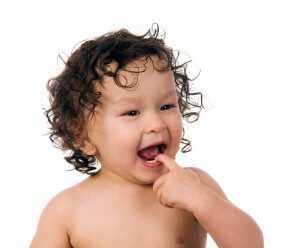
Baby’s first tooth typically appears between the ages of 6 and 10 months. However, it can be much earlier or later. Occasionally, babies are born with teeth. Others remain toothless until their first birthday.
You’ll probably know when your baby’s first tooth is about to erupt, because they’ll display some of these common teething symptoms:
- Drooling
- Chewing on fingers/toys
- Redness or a rash around the mouth, chin and neck
- Irritability and crying
- Waking more often at night
- Ear pulling
- Fussy eating
This can happen every time there are baby teeth coming in, so you’ll want to be prepared with some ways to relieve pain from teething.
Most children have their full set of teeth by age three. You can see full details of when babies get their teeth in the milk teeth chart a little further down. Baby teeth are also called ‘deciduous teeth’ (because they fall out) and ‘primary teeth’.
A baby’s first tooth typically erupts between 6 to 12 months. When this happens, your baby’s gums might be sore and tender — a condition that ca last until 3 years of age.
To relieve this irritation, you can gently rub sore gums with a cold, wet cloth, and you can also use teething rings. During teething, make sure that there is no baby bottle decay — this can be done by checking the tongue or the inside of teeth for abnormally white spots or lines.
Dr. Angela Evanson, Angela Evanson DDS
How many baby teeth do children get?
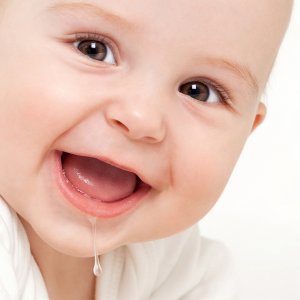
We have 20 baby teeth in total, with each jaw having 4 incisors (front teeth for biting), 2 canines (pointy teeth for biting), and 4 molars (back teeth for chewing).
Around 1% of children are born missing one or more of their primary teeth, a condition called hypodontia. They can also have extra teeth, which is known as hyperdontia. Both of these conditions are more likely to affect adult teeth than deciduous teeth, though.
Baby teeth order
The baby teeth that come in first are the incisors, which are for biting. Some time after baby’s first birthday their molars will appear, enabling them to chew food better. Then the canines come through, and finally the second molars complete the set. You’ll notice that this order of baby teeth coming in means that they will have a small gap for a while between the second and fourth teeth, so don’t be alarmed!
Each pair of teeth (on the left and right) should appear at about the same time, but the upper and lower can be a month or two apart.
Baby teeth chart
Check this baby teeth chart to see what order baby teeth come in, at what age they usually appear, and then when they fall out.
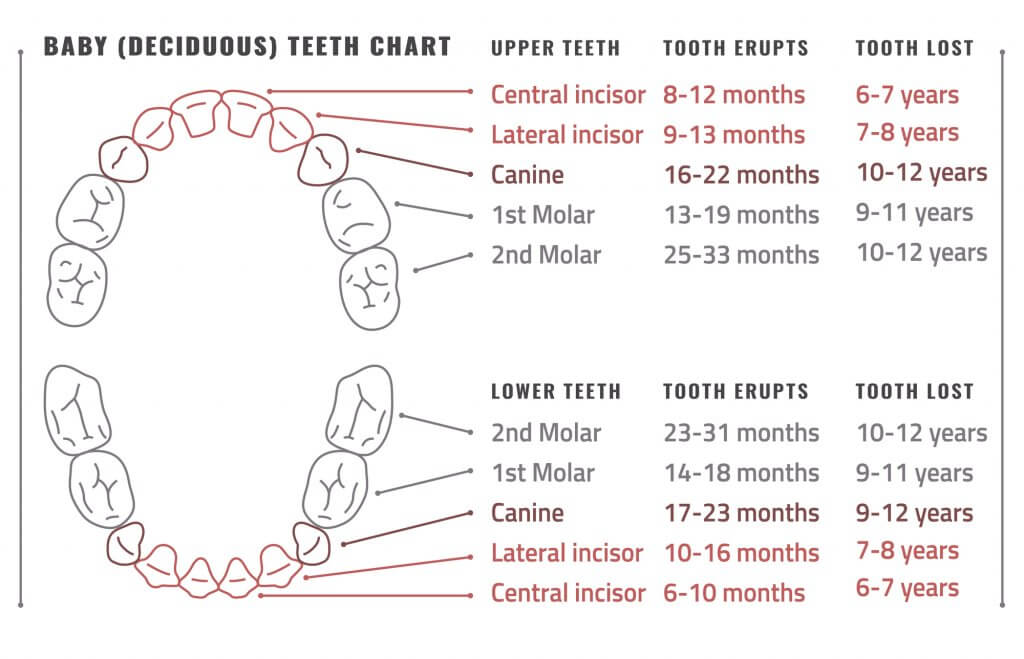
Note that these are average ages and it’s usually not a cause for concern if a child’s teeth appear outside these ranges, or even in a different order. However, we recommend you consult a dentist if you’re concerned about when your baby’s teeth are coming in.
When do baby teeth fall out?
You can see from the chart above that the first milk teeth fall out around age 6, making way for the permanent adult teeth. Deciduous should fall out in more or less the same order as they came in. That means the molars are the last to go by age 12.
If your child’s baby teeth came in particularly early or late, they are likely to follow the same pattern when they fall out. You can read more about how many adult teeth we get and when they appear in our separate article on this topic.
Problems with milk teeth
You want your child’s teeth to be strong and healthy, so you’re bound to pick up on anything that seems out of the ordinary. Some things might be nothing to worry about, but others might require dental treatment, so we recommend speaking to a dentist about any concerns.
Here’s a run-down of some of the most common baby teeth problems that you might want to know about:
Baby teeth coming in late
The baby teeth chart above gives the average timeline for baby teeth coming in, but every child is different. Milk teeth can erupt earlier or later than this.
If your child’s baby teeth are coming in late compared to this, it’s probably nothing to worry about, but you can mention it to their dentist if you’re concerned. The main problem is likely to be the frustration (for you and your baby) of being limited to softer foods for longer!
White spots on baby teeth
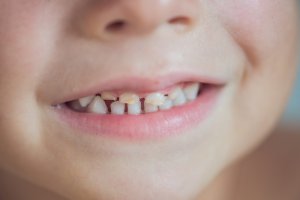
There are two main causes of white spots on baby teeth: early tooth decay and dental fluorosis.
White spots along the gumline can be one of the first signs of tooth decay. If left, the decay will turn brown then black and will need to be removed and filled. Fortunately, if you spot it at this early stage, it’s possible to reverse the damage. Your dentist might clean your child’s teeth properly, apply fluoride varnish, and help you improve their daily teeth cleaning routine.
If the white marks are caused by dental fluorosis – which occurs when too much fluoride is consumed while the teeth are developing – they aren’t reversible. However, there are measures you may be able to take to avoid any further damage to unerupted teeth, if high fluoride intake is still a risk.
If you notice white marks or any other discolouration on your child’s teeth, take them for a checkup ASAP. Whatever is causing the problem, your dentist can diagnose it and advise you on the best treatment or preventative action.
Baby grinding teeth
Teeth grinding (bruxism) in children is quite common, especially at night, but it should stop by the time all their milk teeth have come through. It can be a response to teething pain, but it might also be linked to stress or hyperactivity.
Mention it to your dentist if any of the following accompany your baby’s teeth grinding:
- Waking with a sore face or jaw
- Waking frequently because of the teeth grinding
- Signs of wear on the teeth
- Anything else that concerns you
Baby teeth gaps
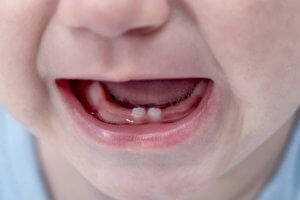
It’s normal for the fourth tooth to appear before the third, so most babies have a gap between the second and fourth teeth for a little while.
But what about gaps between baby teeth after they have all erupted? Gaps are quite normal, especially between the top front teeth, and you might notice them more as your child’s jaw expands.
When the larger adult teeth come in, everything may well change. But even if your child still has gaps in their teeth, this can be easily treated with children’s braces.
In the meantime, make sure you pay special attention when brushing their teeth as it’s easy for food to get stuck in small gaps. Also be aware that a gap between the bottom front teeth can be a sign of tongue tie, so mention this to your doctor or dentist if you’re concerned.
Milk teeth growing crooked
Don’t be too concerned if your baby’s first teeth are not perfectly straight. They may correct themselves over time, and even if they don’t, crooked baby teeth don’t necessarily mean crooked adult teeth. However, be aware that dummy use past age one can contribute to misaligned teeth and jaws, or ‘dummy teeth‘.
Losing baby teeth early
Primary teeth serve an important purpose in keeping space free for the adult teeth growing below them. Losing baby teeth early can be a problem, therefore, because the other teeth may shift position and cause the adult teeth to grow in crooked. Baby teeth also help with proper speech development.
Sadly, child tooth decay is still a big problem in the UK, with over 100 children being admitted to hospital for tooth extractions every day. 2.4% of children in England have had a rotten baby tooth extracted by age five, according to a report from Public Health England.
Another reason for losing baby teeth early is trauma; accidents can happen at any time and cause a tooth to be knocked out or damaged beyond repair.
Although less common, there are some medical conditions which can cause teeth to fall out early. If your child loses a tooth before age 4, not because of trauma or decay, then you should take them to the dentist.
When a baby tooth is lost early, whatever the reason, the dentist may decide to insert a space maintainer. This is a small device made from acrylic or metal which stops the two neighbouring teeth from moving into the gap left by the missing baby tooth. This reduces the chances of alignment problems with the adult teeth.
Brushing baby teeth
When to start brushing baby’s teeth
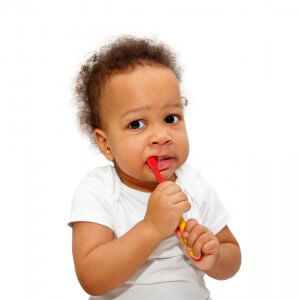
If you’re wondering when to start brushing baby’s teeth, the answer is simple: as soon as the first baby tooth appears. In fact, you can even begin brushing their gums with a silicone finger toothbrush before their first tooth erupts. This gets them used to the feeling so they are less likely to resist when you need to brush their teeth.
Make sure your baby’s toothbrush has a small head and super soft bristles. To find out more about the best toothbrush for your baby or child, read our separate guide which has plenty of product recommendations and reviews.
You should use a fluoride toothpaste to help protect your child’s baby teeth from decay, but only use a smear (about the size of a grain of rice) for children up to age 3, and a pea-sized amount thereafter. Using more than the recommended amount increases the chances of them developing fluorosis if they swallow the toothpaste. Our children’s toothpaste guide has more about how to choose the right product for your baby or child.
How to brush baby teeth
Equipped with a suitable toothbrush and toothpaste, you’re ready to get brushing. Here’s how:
- Brush baby’s teeth twice a day: once before bedtime and at one other time during the day.
- Use small circular motions to brush all the surfaces of each tooth.
- Make sure they spit out any excess toothpaste, rather than swallowing it.
- Don’t rinse with water afterwards, as this washes off some of the fluoride in the toothpaste.
- By the time your child has all their milk teeth you should be brushing for 2 minutes each time.
- Continue to help until they are old enough to brush their teeth properly, usually around age 7.
Your baby might not like the feeling at first, and may resist by turning away, closing their lips, or biting the toothbrush. Let them watch you brushing your teeth, and try singing a song or turning it into a game to make it more fun for them. Don’t worry if you aren’t able to follow this full routine at first, but keep trying until you baby is used to having their teeth brushed.
Brushing your baby’s teeth is only part of the picture when it comes to keeping them in good condition. You should also limit your child’s sugar intake to minimise plaque buildup on their teeth. Our complete guide to children’s oral health has more information on how to prevent tooth decay and keep both deciduous and permanent teeth healthy.
Watch the video below for more tips when it comes to caring for milk teeth:
When to take baby to the dentist
Children should attend their first dental checkup by the age of one, according to the British Society of Paediatric Dentistry, but less than 3% of babies actually do. Even if they have just a couple of baby teeth showing, the dentist will check their teeth and gums and will be able to answer any questions you have. At some point, your dentist may recommend applying fluoride varnish to add an extra layer of protection to your child’s milk teeth. Dental sealant can also help prevent decay on teeth with deep pits and fissures.
Children who visit an NHS dentist will receive free checkups and treatment up to age 18, so make sure you take advantage of this.
Keep taking your child for regular dental checkups, as advised by their dentist, even if you think their teeth are healthy. It’s good for them to get used to dental visits so they don’t mind going when they’re older. Plus, if there are any potential problems, the dentist will be able to spot and treat them early on – much better than waiting until they become a real issue for your child. If you need help finding an NHS dentist, read our article here.
Conclusion
Deciduous teeth play an important part in your child’s development, and you have a big part to play in keeping those teeth healthy. We hope this article has answered all your questions about baby teeth order, how many milk teeth to expect, and when they appear.
You’ve read about how to brush baby teeth, although putting it into practice can be tricky. Keep persevering, because without proper brushing, decay can develop. If you’re concerned about anything relating to your child’s teeth, take them for a dental checkup. It may be nothing serious, but better safe than sorry when it comes to dental health.
Dentistry.co.uk: Less than 3% of children under one attending the dentist. Consulted 4th January 2019.
Public Health England: National Dental Epidemiology Programme for England: oral health survey of five-year-old children 2017. Consulted 4th January 2019.




